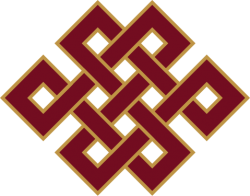Endless knot
Jump to navigation
Jump to search
The endless knot or eternal knot (Sanskrit: Shrivatsa; Tibetan Dpal be'u) is a symbolic knot and one of the Eight Auspicious Symbols. It is an important cultural marker in places significantly influenced by Tibetan Buddhism such as Tibet, Mongolia, Tuva, Kalmykia, and Buryatia. It is also sometimes found in Chinese art and used in Chinese knots.
Interpretations
The endless knot has been described as "an ancient symbol representing the interweaving of the Spiritual path, the flowing of Time and Movement within That Which is Eternal. All existence, it says, is bound by time and change, yet ultimately rests serenely within the Divine and the Eternal. Various interpretations of the symbol are:
- Eternal Love and Friendship
- The Endless knot iconography symbolised Samsara i.e., the endless cycle of suffering or birth, death and rebirth within Tibetan Buddhism.
- The inter-twining of wisdom and compassion.
- Interplay and interaction of the opposing forces in the dualistic world of manifestation, leading to their union, and ultimately to harmony in the universe.
- The mutual dependence of religious doctrine and secular affairs.
- The union of wisdom and method.
- The inseparability of emptiness (shunyata) and dependent origination, the underlying reality of existence.
- Symbolic of knot symbolism in linking ancestors and omnipresence and the magical ritual and meta-process of binding (refer etymology of Tantra, Yoga and religion) (see Namkha.)
- Since the knot has no beginning or end it also symbolizes the wisdom of the Buddha.

